Piper J-3 Video - Picture
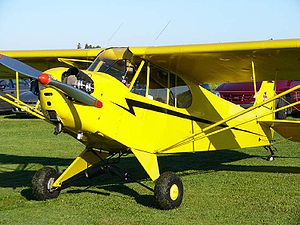
|
|
Piper J-3
J-3 Cub

Picture - Piper J-3 Cub
Role: Trainer
Manufacturer: Piper
Designed by: C. G. Taylor
Walter Jamouneau
First flight: 1938
Produced: 1938-1947
Number built: 19,888 (US built)
150 (Canadian-built)
253 TG-8 gliders
Unit cost: $995-$2,461 when new
Variants: PA-15 Vagabond
PA-16 Clipper
PA-18 Super Cub
The Piper J-3 Cub is a small, simple, light aircraft that was built between 1937 and 1947 by Piper Aircraft. With tandem (fore and aft) seating, it was intended for flight training but became one of the most popular and best-known light aircraft of all time. The Cub's simplicity, affordability and popularity invokes comparisons to the Ford Model T automobile.
The aircraft's standard yellow paint has come to be known as âCub Yellowâ or "Lock Haven Yellow".
Pre-war
The Taylor E-2 Cub first appeared in 1930, built by Taylor Aircraft in Bradford, Pennsylvania. Sponsored by William T. Piper, a Bradford industrialist who had invested in the company, the E-2 was meant to be an affordable aircraft that would encourage interest in aviation. Later in 1930, the company went bankrupt, with Piper buying the assets but keeping founder C. Gilbert Taylor on as president. In 1936, an earlier Cub was altered by employee Walter Jamouneau to become the J-2 while Taylor was on sick leave. (The coincidence led some to believe that the "J" stood for Jamouneau, while aviation historian Peter Bowers concluded that the letter simply followed the E, F, G, and H models, with the I omitted because it could be mistaken for the numeral one.). When he saw the redesign, Taylor was so incensed that he fired Jamouneau. Piper, however, had encouraged Jamouneau's changes, and hired him back. Piper then bought Taylor's share in the company, paying him US$250 per month for three years.
Although sales were initially slow, about 1,200 J-2s were produced before a fire in the Piper factory ended its production in 1938. After Piper moved his company from Bradford to Lock Haven, the J-3, which featured further changes by Jamouneau, replaced the J-2. Powered by a 40 hp (30 kW) engine, in 1938, it sold for just over $1,000.
The outbreak of hostilities in Europe in 1939, coupled with the growing realization that the United States might soon be drawn into World War II, resulted in the formation of the Civilian Pilot Training Program (CPTP). The Piper J-3 Cub would play an integral role in the success of the CPTP, achieving legendary status.
A number of different engines, air-cooled flat-4 boxer engine configuration and a very few examples equipped with Lenape 3-cylinder radial engines were used to power J-3 Cubs, and resulted in differing model designations for each type: the J3C model used the Continental A-65, the J3F used the Franklin 4AC engine, and the J3L used the Lycoming O-145.
The Piper J-3 Cub became the primary trainer aircraft of the CPTP - 75 percent of all new pilots in the CPTP (from a total of 435,165 graduates) were trained in Cubs. By war's end, 80 percent of all United States military pilots received their initial flight training in Piper Cubs. The need for new pilots created an insatiable appetite for the Cub. In 1940, the year before the United States' entry into the war, 3,016 Cubs were built; soon, wartime demands would increase that production rate to one Piper J-3 Cub being built every 20 minutes.
Flitfire
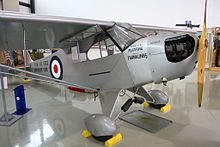
Picture - Flitfire, used in RAF Benevolent Fund and war bond efforts
Prior to the United States entering World War II, J-3s were part of a fund-raising programs to support the United Kingdom. Billed as a Flitfire, a Piper Cub J3 bearing Royal Air Force insignia was donated by W. T. Piper and Franklin Motors to the RAF Benevolent Fund to be raffled off. Piper distributors nationwide were encouraged to do the same, one for each of the then 48 US states. On April 29, 1941 all 48 aircraft flew into La Guardia Field for a dedication and fundraising event which included Royal Navy officers from the battleship HMS Malaya, in New York for repairs, as honored guests. At least three of the original Flitfires are known to exist in the 21st century - one, on display and restored to its original silver-doped finish, powered with a Franklin 65 engine it is on display at the North Carolina Aviation Museum in Asheboro, North Carolina. This Flitfire was flown by Orville Wright in a war bond promotion campaign. The second one, still actively flown as of 2010, is based in Snohomish, Washington restored to its original silver "Flitfire" finish.. The third one is powered by a Continental 65 engine, has been restored to its original finish and is actively flown from Alabama's Moontown Airport as of 2011.
World War II service

Picture - L-4A painted and marked to represent an aircraft that flew in support of the Allied invasion of North Africa in November 1942
The Piper Cub quickly became a familiar sight. First Lady Eleanor Roosevelt took a flight in a J-3 Cub, posing for a series of publicity photos to help promote the CPTP. Newsreels and newspapers of the era often featured images of wartime leaders, such as Generals Dwight Eisenhower, George Patton and George Marshall, flying around European battlefields in Piper Cubs. Civilian-owned Cubs joined the war effort as part of the newly formed Civil Air Patrol (CAP), patrolling the Eastern Seaboard and Gulf Coast in a constant search for German U-boats and survivors of U-boat attacks.

Picture - A Piper Cub of the 1st Marine Divisionâs improvised air force snags a message from a patrol on New Britain's north coast.
Piper developed a military variant ("All we had to do," Bill Jr. is quoted as saying, "was paint the Cub olive drab to produce a military airplane"), variously designated as the O-59 (1941), L-4 (after April 1942), and NE (U.S. Navy). The variety of models, as well as similar, tandem-cockpit accommodation aircraft from Aeronca and Taylorcraft, were collectively nicknamed âGrasshoppersâ and used extensively in World War II for reconnaissance, transporting supplies and medical evacuation. L-4s were also sometimes equipped with lashed-on infantry bazookas for ground attack. These proved to be most useful during Operation Overlord, in the hedgerowed bocage country south of the invasion beaches, for spotting hidden German tanks waiting in ambush for American and British tanks of the invasion forces. Since the L-4 Grasshoppers were mechanically identical to the J-3 civilian version, the military versions were distinguished by the presence of rearwards-entended Plexiglas windows going over the top of the wing and behind the rear-seat passenger, somewhat aft of the wing's trailing edge. Nearly 5,700 L-4s were produced for the U.S. Army and 250 for the U.S. Navy as "elementary trainers".
In Europe, the final dogfight of WWII occurred between an L-4 and a German Fieseler Fi 156 Storch. The pilot and co-pilot of the L-4, Lts. Duane Francis and Bill Martin, opened fire on the Storch with their .45 caliber pistols, forcing the German air crew to land and surrender.
After the war, most L-4s were destroyed or sold as surplus, but a few saw service in the Korean War. The Grasshoppers sold as surplus in the U.S. were redesignated as J-3s, but often retained their wartime glazing and paint.
Postwar
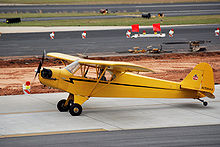
Picture - A Piper Cub
An icon of the era, and of American general aviation in general, the J-3 Cub has long been loved by pilots and non-pilots alike, with thousands still in use today. Piper sold 19,073 J-3s between 1938 and 1947, the majority of them L-4s and other military variants. Postwar, thousands of Grasshoppers were civilian-registered under the designation J-3. Hundreds of Cubs were assembled from parts in Canada (by Cub Aircraft as the Cub Prospector), Denmark and Argentina, and by a licensee in Oklahoma.
In the late 1940s, the J-3 was replaced by the Piper PA-11 Cub Special (1,500 produced), the first Piper Cub version to have a fully-enclosed cowling for its powerplant, and then the Piper PA-18 Super Cub, which Piper produced until 1981 when it sold the rights to WTA Inc. In all, Piper produced 2,650 Super Cubs. The Super Cub had a 150 hp (110 kW) engine which increased its top speed to 130 mph (210 km/h); its range was 460 miles (740 km).
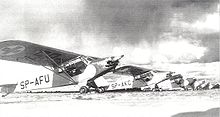
Picture - Polish L-4 Cubs in 1951, used in the air ambulance role.
Modernized and up-engined versions are produced today by Cub Crafters of Washington and by American Legend Aircraft in Texas, as the Cub continues to be sought after by bush pilots for its STOL capabilities, as well as by recreational pilots for its nostalgia appeal. The new aircraft are actually modeled on the PA-11, though the Legend company does sell an open-cowl version with the cylinder heads exposed, like the J-3 Cub. An electrical system is standard from both manufacturers.
So popular is the J-3 as a subject for radio controlled model aircraft that manufacturers of R/C heat shrinkable iron-on covering film and similar fabric coverings produce it in a readily available Cub Yellow hue.
The J-3 is distinguished from its successors by having a cowl that exposes its engine's cylinder heads. There are very few other examples of "flat" aircraft engine installations (as opposed to radial engines) in which the cylinder heads are exposed. From the PA-11 on through the present Super Cub models, the cowling surrounds the cylinder heads.
A curiosity of the J-3 is that when it is flown solo, the lone pilot normally occupies the rear seat for proper balance, to balance the fuel tank located at the firewall. Starting with the PA-11, and some L-4s, fuel was carried in wing tanks, allowing the pilot to fly solo from the front seat.
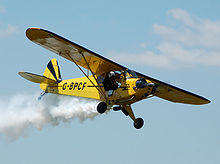
Picture - Piper J3C-65 displays at Cotswold Airport, Gloucestershire, England in 2010. This aircraft is part of O'Briens Flying Circus Aerobatic Stunt Team.
Variants
Civil variants
J-3
Equipped with a Continental A-40, A-40-2 or A-40-3 engine of 37 hp (28 kW), or A-40-4 engine of 40 hp (30 kW)
J3C-40
Certified 14 July 1938 and equipped with a Continental A-40-4 or A-40-5 of 40 hp (30 kW)
J3C-50
Certified 14 July 1938 and equipped with a Continental A-50-1 or A-40-2 to -9 (inclusive) of 50 hp (37 kW)
J3C-50S
Certified 14 July 1938 and equipped with a Continental A-50-1 or A-40-2 to -9 (inclusive) of 50 hp (37 kW). Equipped with optional float kit.
J3C-65
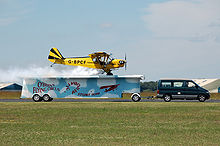
Picture - Piper J3C-65 lands on a moving trailer at Cotswold Airport, Gloucestershire, England, in 2010. This aircraft is shown in closeup above.
Certified 6 July 1939 and equipped with a Continental A-65-1 or A-65-3, 6, 7, 8, 8F, 9 or 14 of 65 hp (48 kW) or an A-65-14, Continental A-75-8, A-75-8-9 or A-75-12 of 75 hp (56 kW) or Continental A-85-8 or C-85-12 of 85 hp (63 kW) or Continental A-90-8F of 90 hp (67 kW)
J3C-65S
Certified 27 May 1940 and equipped with a Continental A-65-1 or A-65-3, 6, 7, 8, 8F, 9 or 14 of 65 hp (48 kW) or an A-65-14, Continental A-75-8, A-75-8-9 or A-75-12 of 75 hp (56 kW) or Continental A-85-8 or C-85-12 of 85 hp (63 kW) or Continental A-90-8F of 90 hp (67 kW). Equipped with optional float kit.
J3F-50
Certified 14 July 1938 and equipped with a Franklin 4AC-150 Series 50 of 50 hp (37 kW)
J3F-50S
Certified 14 July 1938 and equipped with a Franklin 4AC-150 Series 50 of 50 hp (37 kW). Equipped with optional float kit.
J3F-60
Certified 13 April 1940 and equipped with a Franklin 4AC-150 Series A of 65 hp (48 kW) or a Franklin 4AC-171 of 60 hp (45 kW).
J3F-60S
Certified 31 May 1940 and equipped with a Franklin 4AC-150 Series A of 65 hp (48 kW) or a Franklin 4AC-171 of 60 hp (45 kW). Equipped with optional float kit.
J3F-65
Certified 7 August 1940 and equipped with a Franklin 4AC-176-B2 or a Franklin 4AC-176-BA2 of 65 hp (48 kW).
J3F-65S
Certified 4 January 1943 and equipped with a Franklin 4AC-176-B2 or a Franklin 4AC-176-BA2 of 65 hp (48 kW). Equipped with optional float kit.
J3L
Certified 17 September 1938 and equipped with a Lycoming O-145-A1 of 50 hp (37 kW) or a Lycoming O-145-A2 or A3 of 55 hp (41 kW)
J3L-S
Certified 2 May 1939 and equipped with a Lycoming O-145-A1 of 50 hp (37 kW) or a Lycoming O-145-A2 or A3 of 55 hp (41 kW). Equipped with optional float kit.
J3L-65
Certified 27 May 1940 and equipped with a Lycoming O-145-B1, B2 or B3 of 65 hp (48 kW)
J3L-65S
Certified 27 May 1940 and equipped with a Lycoming O-145-B1, B2 or B3 of 65 hp (48 kW). Equipped with optional float kit.
J3P
Variant powered by a 50 hp (37 kW) Lenape LM-3-50 or Lenape AR-3-160 engine.
J-3R
Variant with slotted flaps powered by a 65 hp (48 kW) Lenape LM-3-65 engine.
J-3X
1944 variant with cantilever wing powered by a 65 hp (48 kW) Continental A-65-8 engine.
Military designations and variants
YO-59
Test and evaluation aircraft. Four Piper J3C-65s were sold to the US Army Air Corps for evaluation.
O-59
Production two-seat observation, liasion aircraft for the USAAC; 140 built later re-designated L-4.
O-59A
Improved version, powered by a 65-hp (48-kW) Continental O-170-3 piston engine; 948 built, later re-designated L-4A.
L-4
Resignation of the YO-59 and O-59.
L-4A
Redesignation of the O-59A.
L-4B
Similar to the L-4A, but without radio equipment; 980 built.
L-4C
Eight impressed J3L-65s, first two originally designated UC-83A.
L-4D
Five impressed J3F-65s.
L-4H
Similar to the L-4B but with equipment improved and fixed-pitch propeller, 1801 built.
L-4J
Same as the L-4H but with controllable-pitch propeller, 1680 built.
UC-83A
Two impressed J3L-65s later re-designated L-4C.
TG-8
Three-seat training glider variant, 250 built.
LNP
Three TG-8 training glider variant for the United States Navy.
NE-1
United States Navy designation for the J3C-65 with dual controls, 230 built.
NE-2
Same as NE-1 with minor equipment changes, 20 built.
Operators
Civil operators
The aircraft has been popular with flying schools and remains so with private individuals.
Military operators
Paraguay
Military of Paraguay - L-4
South Korea
South Korean Air Force
Thailand
Royal Thai Air Force
United Kingdom
Royal Air Force
United States
United States Air Force
United States Army
United States Army Air Force
United States Navy
Specifications (J3C-65 Cub)
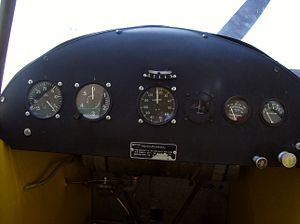
Picture - Inside the cockpit of a Piper Cub. The aircraft has far fewer instruments than more modern aircraft.
Data from The Piper Cub Story
General characteristics
Crew: one pilot
Capacity: one passenger
Length: 22 ft 5 in (6.83 m)
Wingspan: 35 ft 3 in (10.74 m)
Height: 6 ft 8 in (2.03 m)
Wing area: 178.5 ft² (16.58 m²)
Empty weight: 765 lb (345 kg)
Useful load: 455 lb (205 kg)
Max takeoff weight: 1,220 lb (550 kg)
Powerplant: 1x Continental A-65-8 air-cooled flat four, 65 hp (48 kW) at 2,350 rpm
Performance
Maximum speed: 76 kn (87 mph, 140 km/h)
Cruise speed: 65 kn (75 mph, 121 km/h)
Range: 191 NM (220 mi, 354 km)
Service ceiling: 11,500 ft (3,500 m)
Rate of climb: 450 ft/min (2.3 m/s)
Wing loading: 6.84 lb/ft² (33.4 kg/m²)
Power/mass: 18.75 lb/hp (11.35 kg/kW)
Related development
Piper J-2
Piper PA-15 Vagabond
Piper PA-16 Clipper
Piper PA-20 Pacer
Piper PA-18 Super Cub
American Legend Aircraft Company Legend Cub
CubCrafters CC11-100 Sport Cub S2
Wag-Aero CUBy
Wag-Aero Sport Trainer
LIPNUR Belalang
Comparable aircraft
Aeronca Champ
Fieseler Fi 156 Storch
Kitfox Model 5
Taylorcraft BC-65
Taylorcraft L-2
Aeronca L-3
Zlin Savage Cub
Andrade, John (1979). U.S.Military Aircraft Designations and Serials since 1909. Midland Counties Publications. ISBN ISBN 0 904597 22 9.
Bowers, Peter M. (1993). Piper Cubs. McGraw Hill. ISBN 0-8306-2170-9.
Peperell, Roger W; Smith, Colin M (1987). Piper Aircraft and their Forerunners. Air-Britain. ISBN 0 85130 149 5.
Piper J-3 Pictures
More aircraft.
Source: WikiPedia